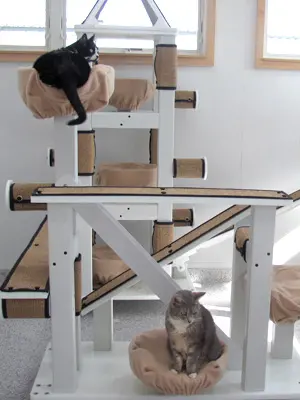Selecting Healthy, Compatible Cats for Communal Rooms

Most organizations agree that group housing should be limited to healthy, adoptable cats – so once cats are available for adoption, they may be displayed in group rooms.
Along with healthy cats, a successful communal group requires compatible (or, at least, not incompatible) cats. It is recommended that shelters consult their veterinarians to establish selection protocols appropriate to their individual needs and capabilities.
Keep reading for a list of general recommendations to keep in mind.
Health Criteria
- Ideally, cats should be considered for social living only after they have been fully vaccinated, dewormed, tested for FeLV/FIV, screened for ringworm, and spayed or neutered. Vaccination recommendations are available here.
- Any animal of reproductive age should be spayed and neutered.
- Cats requiring a special diet or having other special needs should not be included in a communal room (except, perhaps, in a room dedicated to special-needs cats).
- In general, no cat with a communicable illness should be housed in a group environment. Some shelters do house cats with the same condition – for example, upper respiratory infections or FeLV positive cats – together in order to improve their chances of early adoption. Be sure that potential adopters understand that a cat adopted from these colonies will need care and treatment.
Age
For purposes of both health and compatibility, it is best to group cats according to age:
- Kittens (8 weeks-5 months)
- Juveniles (6 mos-1year)
- Adults (> 1year)
- Seniors (10 years+)
Behavior
The Association of Shelter Veterinarians Guidelines for Standards of Care in Animal Shelters states that grouping cats at random is unacceptable and that a considered selection process is necessary. In a perfect world, all candidates for communal living would be assessed by a qualified behaviorist to determine compatibility with other cats. Where a behaviorist is unavailable, experienced shelter personnel can make the assessment, mindful of the following general guidelines:
- Related cats or cats from the same home/environment make good group mates.
- Aggressive, overly dominant cats should be excluded or removed from a group setting.
- Extremely timid or fearful cats are poor candidates, though they can sometimes beneficially be housed together or with young cats.
- Cats socialized to humans or other animals can make good candidates.
